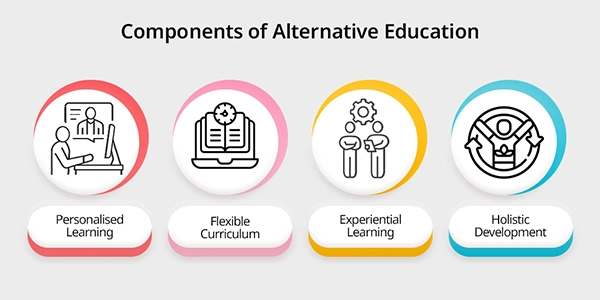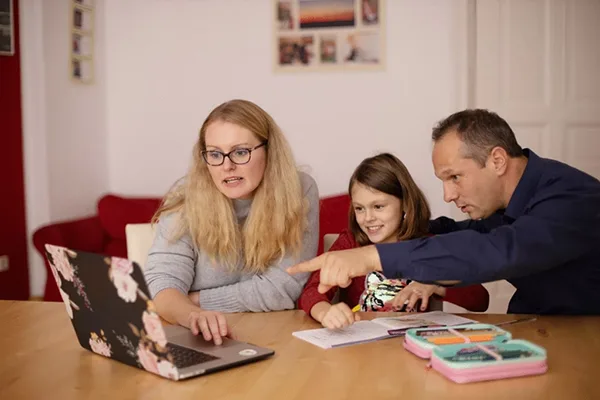
As we all know, technology and lifestyle have changed everything around us, and education has become the pioneer in adopting new strategies to become more accessible and flexible for the younger generation.

Parents are pulling their children out of regular schools faster than ever before. Some people convert dining rooms into classrooms. Others pack up and relocate to Bali to pursue “worldschooling.”
A growing number are checking out international schools in Singapore, despite jaw-dropping tuition costs. What is fueling this exodus? Sometimes it’s a child who thinks in pictures but is forced to use words.
Sometimes it’s parents watching their straight-A student have panic attacks over test results. Frequently, it’s the simple realization that memorizing state capitals will not help anyone navigate the gig economy.
That’s why in this blog post, we are going to explore more layers of this segment and provide valuable insights to the readers.
Let’s begin!
Key Takeaways
- Understanding why one format is not suitable for everyone
- Discovering the benefits of homeschooling
- Looking at some apprenticeships and other growth opportunities
- Choosing the right options for the future
Why One Size Doesn’t Fit All
Here’s the thing nobody wants to admit: school as we know it was designed to create obedient factory workers. Bells ring, you move. Sit in rows. Ask permission to pee.
This made perfect sense in 1902. Factory jobs needed humans who could follow schedules and handle repetitive tasks without complaining. But when was the last time following directions without thinking got anyone promoted?
Watch any class. For one hour, the kid who finishes math problems in three minutes, then spends the next twenty minutes drawing robots in her notebook. Two rows, another student continues to struggle with the first problem and feels dumber by the second. is broken.
My friend teaches fifth grade in Brooklyn. She says the hardest part isn’t teaching—it’s watching bright kids slowly believe they’re stupid because they don’t fit the mold. They might be brilliant visual thinkers forced to prove intelligence through essays. Or kinesthetic learners trapped at desks when their bodies scream to move.
Companies today beg for creative thinkers and problem solvers. They want employees who question everything and adapt quickly. Yet we train kids to sit quietly, regurgitate information, and never color outside the lines.
Intriguing Insights

This infographic shows the core elements of alternative education
The Homeschooling Revolution

Five years ago, admitting you homeschooled was social suicide. People pictured denim jumpers and kids who couldn’t make eye contact. How times have changed.
The pandemic turned every parent into an accidental homeschooler. Most hated it. But some discovered their kids actually thrived without classroom chaos. No bullies. No busywork. No teaching to the lowest common denominator.
Homeschooling no longer seemed so crazy. Your child could sleep until their teenage brain was functional. If ancient Rome piqued your interest, you could spend six weeks studying it, or you could get through it in a matter of days.
Take the Morrison family from Portland. Their daughter struggled with dyslexia in public school, always three steps behind despite being wickedly smart. They pulled her out in sixth grade. Mom teaches mornings while running her consulting business. Dad takes afternoons.
Their daughter now devours audiobooks, builds complex Minecraft worlds that would make architects weep, and reads at her own pace without shame. She joined a homeschool soccer league and a robotics club. Nobody calls her slow anymore.
But homeschooling isn’t some magic cure. I’ve watched families crash and burn trying it. Parents discover they have zero patience for teaching long division. Kids miss their friends desperately. The house becomes a battlefield by February.
The social question haunts every homeschool parent. How do you raise a normal kid without the natural social laboratory of school? Most cobble together solutions—park meetups, sports teams, theater groups. It works, but it takes effort. You become a full-time social coordinator on top of teacher, parent, and whatever else pays the bills.
The math speaks for itself. Singapore private school fees might run forty thousand dollars yearly, but homeschooling costs whatever you spend on books and WiFi. Sure, someone needs to stay home, but plenty of families already had one parent working remotely anyway.
Online Learning: When the World Becomes Your Classroom
Remember when online school meant your weird cousin getting a GED from some sketchy website? Those days are dead.
MIT professors are now teaching Advanced Placement Physics to students in rural Montana. A student in Thailand learns Latin from a teacher in Scotland. The centuries-long geography lottery that determined educational quality has been disrupted.
The pandemic forced everyone online overnight, and most hated it. Zoom school was a disaster because nobody designed it—we just threw classroom teaching at a webcam and hoped for the best. But intentional online learning? That’s completely different.
Take Synthesis, the online school started by SpaceX engineers. Kids solve complex problems in teams while learning math and science. No grades, no tests, just challenges that get progressively harder. Students log in from bedrooms across forty countries, collaborating like they’re in mission control.
Or consider the explosion of microschools. Eight kids meet in someone’s living room three days a week. The other two days, they learn online. Parents split the hosting duties and hire a facilitator. It costs less than a private school but more than nothing.
My cousin enrolled her son in an online academy based in Florida while they traveled through Europe for her husband’s job. The kid attended live classes at weird hours, turned in assignments from rental apartments, and scored higher on standardized tests than ever before.
But here’s what online learning evangelists won’t tell you: it demands superhuman self-discipline from kids. No teacher notices when you open TikTok in another tab. Nobody makes you pay attention when your camera’s off.
Interesting Facts
A majority of U.S. adults believe alternative education pathways provide a good return on investment, while 55% see them as crucial for future workforce training.

The dropout rates are brutal. Motivated kids soar while others completely fall apart. There’s no middle ground. You either develop iron discipline at fourteen or you fail spectacularly. Some parents think that’s perfect preparation for remote work. Others think it’s insane.
International and Private Schools: Premium Alternatives with Global Perspectives
Walk into any international school in Singapore and you’ll hear six languages before reaching the main office. These aren’t your neighborhood private schools with fancy uniforms and Latin mottos.
A friend moved his family to Singapore for work, expecting to stay two years. That was eight years ago. His kids refused to leave their school, where classmates included a future Korean pop star, the daughter of a diplomat, and kids whose parents ran hedge funds.
The price tag causes most people to choke on their coffee. We’re talking about 60,000 Singapore dollars per child per year. Elementary school tuition equals college tuition. Some families spend more money on one child’s education than the average person does.
But here’s what those eye-watering fees actually buy. Teachers recruited from top universities worldwide. Classes capped at twelve students. Science labs that would make state universities jealous. Every kid gets a laptop, musical instrument lessons, and Mandarin from native speakers.
More importantly, you’re buying a network. These kids grow up comfortable with cultural differences that most adults struggle to navigate. They debate politics with classmates whose parents shape policy. They celebrate Diwali, Chinese New Year, and Thanksgiving in the same semester.
My colleague sent her twins to a local public school, then switched to an international academy. The difference shocked her. Public school focused on standardized test prep. The international school had kids building solar panels and writing business plans.
Still, not everyone drinks the Kool-Aid. Some expat families discover their kids become “third culture”—not quite fitting anywhere. Too Western for Asia, too Asian for home. They speak perfect English but can’t relate to kids back in Ohio.
The bubble effect is real too. When your classmates vacation in Tuscany and everyone’s parents have drivers, regular life seems beneath you. I’ve met international school graduates who can’t comprehend why anyone takes public transportation.
Apprenticeships and Trade Schools: The Comeback Kid of Education
Silicon Valley discovered something Germany has known for decades—apprenticeships create better workers than classrooms. Google now runs apprenticeship programs. So does Microsoft. They’re competing for the same kids who might have become plumbers.
The shift makes sense when you run the numbers. Four years at a decent university costs two hundred thousand dollars. Plumbing school? Maybe thirty thousand. The college graduate starts their career in debt. The plumber starts earning immediately and might own a business by twenty-five.
My plumber drives a Tesla. My friend with a philosophy degree drives Uber.
Trade schools got a terrible reputation somewhere along the way. Guidance counselors pushed them as the consolation prize for kids who couldn’t hack college. Parents felt like failures if their kids chose to weld over pre-med.

Now watch TikTok for five minutes. Young electricians show off beach houses. Female mechanics restore vintage cars and have waitlists for clients. These aren’t your grandfather’s trades—they’re technical, creative, and lucrative.
The technology sector caught on first. Why wait four years for computer science graduates when you can train hungry eighteen-year-olds in six months? These programs cherry-pick motivated kids, teach them exactly what they need, and place them directly into jobs.
Unschooling: The Most Radical Approach
Imagine telling your eight-year-old she never has to study anything she doesn’t want to. No curriculum. No schedule. No tests. Just follow your interests wherever they lead.
Most parents think that’s insane. Unschoolers call it trust.
The Johnsons from Austin unschool three kids. Their twelve-year-old spent six months obsessed with Ancient Egypt. She learned hieroglyphics, mummified a chicken, and built historically accurate pyramids in the backyard. Nobody forced her. She just wanted to know.
Their younger son only cares about cooking. At ten, he runs a weekend pastry stand, calculates profit margins, and watches molecular gastronomy videos for fun. He learned fractions through recipes and chemistry through bread.
Critics imagine unschooled kids playing video games until they’re thirty. Sometimes that happens. Usually, though, boredom breeds curiosity. Kids who never touch math workbooks suddenly need algebra to code their game. They learn because they want something, not because someone makes them.
The legal maze varies wildly by state. Texas requires basically nothing. New York demands quarterly reports and annual testing. Some families move specifically for unschooling freedom. Others fly under the radar and hope nobody asks questions.
Gap Years and Alternative Timing
Americans treat the high school-to-college pipeline like a religious sacrament. Graduate in June, start college in September, or risk ruining your entire life. Meanwhile, British kids routinely take gap years, and somehow Oxford survives.
The tide is turning. Harvard now encourages admitted students to defer enrollment. Google and Apple openly recruit kids who skip college entirely. The old timeline is crumbling.
Emma graduated from high school, burnt out from Advanced Placement everything. Instead of starting Berkeley immediately, she taught English in Vietnam for a year. She returned fluent in Vietnamese, with a clear sense of her major, and emotionally prepared for school. Who among her classmates went straight through? Half of them dropped out by their sophomore year.
Gap years aren’t just for rich kids anymore. Programs exist for every budget. Work on organic farms in Hawaii. Build houses with Habitat for Humanity. Intern at startups for equity instead of pay. The experience matters more than the specifics.
Choosing the Right Path
Before you pull your kid from school tomorrow, ask hard questions. Can you handle being together twenty-four seven? Does your child self-motivate or need external structure? What about special needs services?
Some kids desperately need a traditional school’s routine. Others wither in conventional classrooms but bloom with freedom. Most fall somewhere between. The trick is honestly assessing your specific kid, not some theoretical child.
Money is important too. Homeschooling appears to be free until someone decides to quit their job to teach. Tuition is required at online schools. Alternative programs accumulate quickly.
The Future is Flexible
Traditional school isn’t disappearing. However, its educational monopoly is no longer valid. Today’s children may begin in public school, then move on to homeschooling, an online academy, and finally a trade school. The path matters less than the destination.
Work changed first. Remote jobs, gig economies, and constant career pivots became normal. Education is finally catching up. The future belongs to learners who adapt, not students who memorize.
Find what works for your family. Ignore the judgmental neighbors. Trust your kid more than you trust the system.
Ans: Alternative education refers to any educational approach that deviates from traditional, mainstream methods, offering flexible, student-centered environments and non-conventional teaching strategies to meet diverse learning needs.
Ans: They are the type of curriculum that offers different learning strategies and practice options for the younger generations.
Ans: An alternative class refers to an option different from a typical, or “mainstream,” class, such as a less conventional educational program, a flexible learning environment, or an event that replaces a scheduled class meeting.